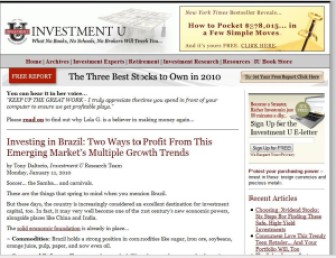 Investment U, a newsletter of a an investment consultants group, released a few days ago a small report about the health of Brazilian Economy to allure their clients into this market. I don’t know their work or credentials, but this report offers a nice summary of what’s going on.
Investment U, a newsletter of a an investment consultants group, released a few days ago a small report about the health of Brazilian Economy to allure their clients into this market. I don’t know their work or credentials, but this report offers a nice summary of what’s going on.
Yes, it is optimistic and, yes, I am sure you will find other specialists that would disagree with their analysis. After all, If you have two economists in a desert island, you will for sure have at least three conflicting opinions. But this could be a good starting point for those beginning to explore Brazilian investments.
Basically, Investment U points out that there is a solid economy foundation:
“~ Commodities: Brazil holds a strong position in commodities like sugar, iron ore, soybeans, orange juice, pulp, paper, and now even oil.
~ Structural Reforms: The country has worked diligently towards structural reforms in recent years – and through improved fiscal and monetary policies, it’s achieved a noticeable improvement. That includes…
- Lowering inflation.
- Reducing net debt to 40% of GDP.
- Paying off its International Monetary Fund loans.
- Aggressively boosting its foreign reserves to $200 billion.
- Achieving an investment grade rating for its debt.
~ A Stricter Central Bank: Brazil’s central bank has moved toward more conservative policies. Among them…
- The current interest rate is 8.75% – a full 4% above the 4.5% inflation rate.
- Brazil’s banks are required to keep 30% of all deposits with the central bank, plus capital reserves of at least 11% of total assets, when most financials outside the country maintain capital ratios of 16% or more
~ Increased Energy Independence: For decades, Brazil has worked hard to boost its energy independence – a strategy that is now paying off big-time. Not only did the nation become self-sufficient in oil last year, it also discovered the world’s largest oil and gas reserves in decades. This improves its chances of becoming a major oil exporter, given that Brazil already derives much of its own electricity from hydro energy and powers many of its cars with sugar cane ethanol.”
The article also points out that:
- much of the country’s growth comes from within, guaranteeing its independence. “A mere 13% of its growth comes from foreign trade, which largely consists of commodity exports to China“, it says.
- “it was the last Latin American country to enter economic recession… but the first to exit from it. Not only that, the country has emerged from the global downturn in better shape than many other countries and estimates call for GDP growth to fall between 4.5% and 5% this year”.
- “In terms of the job market, Brazil has more than made up for the 800,000 jobs it lost during the economic crisis by adding one million jobs over the past six months”.
- “Brazil’s middle-class is growing, too – a trend that is significantly aiding growth. Between 2001 and 2007, Brazil’s poorest 10% enjoyed a 49% jump in real income. And with half of Brazil’s 200 million population now considered “middle class,” credit card purchases have jumped by 22% a year over the past decade. Auto sales hit a record high of 300,000 in June 2009”.
All these facts are not a secret to those that follow the Brazilian market, but it is always refreshing to see this sort of information delivered in such a clear summary.
